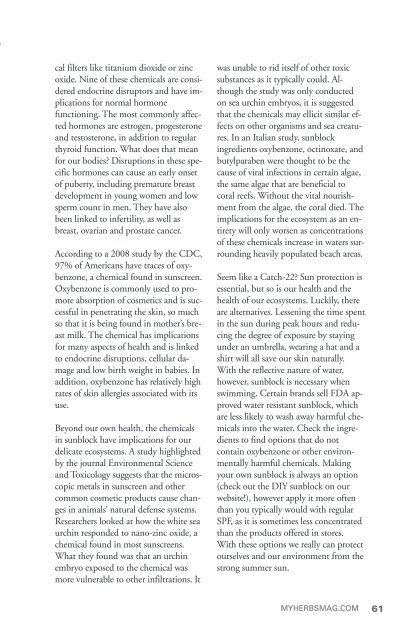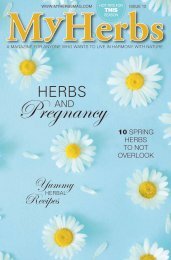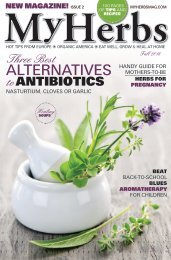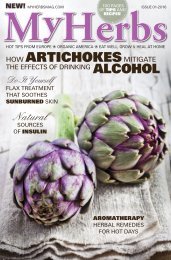My Herbs 1
Find out more on MYHERBS-STORE.COM. My Herbs is a special quarterly publication for anyone who is interested in alternative cooking, home grown herbs, and traditional or complementary medicine or healing methods, simply for everyone who wants to live in harmony with nature.
Find out more on MYHERBS-STORE.COM.
My Herbs is a special quarterly publication for anyone who is interested in alternative cooking, home grown herbs, and traditional or complementary medicine or healing methods, simply for everyone who wants to live in harmony with nature.
You also want an ePaper? Increase the reach of your titles
YUMPU automatically turns print PDFs into web optimized ePapers that Google loves.
cal filters like titanium dioxide or zinc<br />
oxide. Nine of these chemicals are considered<br />
endocrine disruptors and have implications<br />
for normal hormone<br />
functioning. The most commonly affected<br />
hormones are estrogen, progesterone<br />
and testosterone, in addition to regular<br />
thyroid function. What does that mean<br />
for our bodies? Disruptions in these specific<br />
hormones can cause an early onset<br />
of puberty, including premature breast<br />
development in young women and low<br />
sperm count in men. They have also<br />
been linked to infertility, as well as<br />
breast, ovarian and prostate cancer.<br />
According to a 2008 study by the CDC,<br />
97% of Americans have traces of oxybenzone,<br />
a chemical found in sunscreen.<br />
Oxybenzone is commonly used to promote<br />
absorption of cosmetics and is successful<br />
in penetrating the skin, so much<br />
so that it is being found in mother’s breast<br />
milk. The chemical has implications<br />
for many aspects of health and is linked<br />
to endocrine disruptions, cellular damage<br />
and low birth weight in babies. In<br />
addition, oxybenzone has relatively high<br />
rates of skin allergies associated with its<br />
use.<br />
Beyond our own health, the chemicals<br />
in sunblock have implications for our<br />
delicate ecosystems. A study highlighted<br />
by the journal Environmental Science<br />
and Toxicology suggests that the microscopic<br />
metals in sunscreen and other<br />
common cosmetic products cause changes<br />
in animals’ natural defense systems.<br />
Researchers looked at how the white sea<br />
urchin responded to nano-zinc oxide, a<br />
chemical found in most sunscreens.<br />
What they found was that an urchin<br />
embryo exposed to the chemical was<br />
more vulnerable to other infiltrations. It<br />
was unable to rid itself of other toxic<br />
substances as it typically could. Although<br />
the study was only conducted<br />
on sea urchin embryos, it is suggested<br />
that the chemicals may ellicit similar effects<br />
on other organisms and sea creatures.<br />
In an Italian study, sunblock<br />
ingredients oxybenzone, octinoxate, and<br />
butylparaben were thought to be the<br />
cause of viral infections in certain algae,<br />
the same algae that are beneficial to<br />
coral reefs. Without the vital nourishment<br />
from the algae, the coral died. The<br />
implications for the ecosystem as an entirety<br />
will only worsen as concentrations<br />
of these chemicals increase in waters surrounding<br />
heavily populated beach areas.<br />
Seem like a Catch-22? Sun protection is<br />
essential, but so is our health and the<br />
health of our ecosystems. Luckily, there<br />
are alternatives. Lessening the time spent<br />
in the sun during peak hours and reducing<br />
the degree of exposure by staying<br />
under an umbrella, wearing a hat and a<br />
shirt will all save our skin naturally.<br />
With the reflective nature of water,<br />
however, sunblock is necessary when<br />
swimming. Certain brands sell FDA approved<br />
water resistant sunblock, which<br />
are less likely to wash away harmful chemicals<br />
into the water. Check the ingredients<br />
to find options that do not<br />
contain oxybenzone or other environmentally<br />
harmful chemicals. Making<br />
your own sunblock is always an option<br />
(check out the DIY sunblock on our<br />
website!), however apply it more often<br />
than you typically would with regular<br />
SPF, as it is sometimes less concentrated<br />
than the products offered in stores.<br />
With these options we really can protect<br />
ourselves and our environment from the<br />
strong summer sun.<br />
MYHERBSMAG.COM<br />
61












